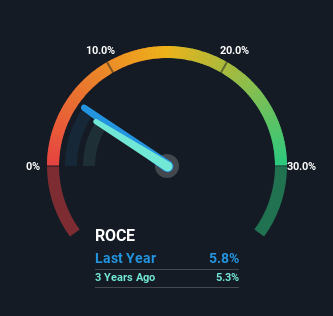- United States
- /
- Building
- /
- NYSE:HAYW
Hayward Holdings (NYSE:HAYW) Hasn't Managed To Accelerate Its Returns

What are the early trends we should look for to identify a stock that could multiply in value over the long term? One common approach is to try and find a company with returns on capital employed (ROCE) that are increasing, in conjunction with a growing amount of capital employed. If you see this, it typically means it's a company with a great business model and plenty of profitable reinvestment opportunities. However, after briefly looking over the numbers, we don't think Hayward Holdings (NYSE:HAYW) has the makings of a multi-bagger going forward, but let's have a look at why that may be.
Return On Capital Employed (ROCE): What Is It?
For those who don't know, ROCE is a measure of a company's yearly pre-tax profit (its return), relative to the capital employed in the business. Analysts use this formula to calculate it for Hayward Holdings:
Return on Capital Employed = Earnings Before Interest and Tax (EBIT) ÷ (Total Assets - Current Liabilities)
0.058 = US$157m ÷ (US$2.9b - US$198m) (Based on the trailing twelve months to September 2023).
Thus, Hayward Holdings has an ROCE of 5.8%. In absolute terms, that's a low return and it also under-performs the Building industry average of 16%.
See our latest analysis for Hayward Holdings

In the above chart we have measured Hayward Holdings' prior ROCE against its prior performance, but the future is arguably more important. If you'd like, you can check out the forecasts from the analysts covering Hayward Holdings here for free.
The Trend Of ROCE
Things have been pretty stable at Hayward Holdings, with its capital employed and returns on that capital staying somewhat the same for the last three years. This tells us the company isn't reinvesting in itself, so it's plausible that it's past the growth phase. So unless we see a substantial change at Hayward Holdings in terms of ROCE and additional investments being made, we wouldn't hold our breath on it being a multi-bagger.
The Bottom Line On Hayward Holdings' ROCE
In summary, Hayward Holdings isn't compounding its earnings but is generating stable returns on the same amount of capital employed. And investors may be recognizing these trends since the stock has only returned a total of 1.7% to shareholders over the last year. As a result, if you're hunting for a multi-bagger, we think you'd have more luck elsewhere.
Hayward Holdings does come with some risks though, we found 2 warning signs in our investment analysis, and 1 of those can't be ignored...
While Hayward Holdings isn't earning the highest return, check out this free list of companies that are earning high returns on equity with solid balance sheets.
Valuation is complex, but we're here to simplify it.
Discover if Hayward Holdings might be undervalued or overvalued with our detailed analysis, featuring fair value estimates, potential risks, dividends, insider trades, and its financial condition.
Access Free AnalysisHave feedback on this article? Concerned about the content? Get in touch with us directly. Alternatively, email editorial-team (at) simplywallst.com.
This article by Simply Wall St is general in nature. We provide commentary based on historical data and analyst forecasts only using an unbiased methodology and our articles are not intended to be financial advice. It does not constitute a recommendation to buy or sell any stock, and does not take account of your objectives, or your financial situation. We aim to bring you long-term focused analysis driven by fundamental data. Note that our analysis may not factor in the latest price-sensitive company announcements or qualitative material. Simply Wall St has no position in any stocks mentioned.
About NYSE:HAYW
Hayward Holdings
Designs, manufactures, and markets a portfolio of pool equipment and associated automation systems in North America, Europe, and internationally.
Solid track record and slightly overvalued.
Market Insights
Community Narratives




